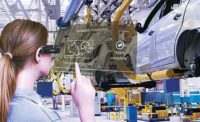All that glitters is not gold. Shakespeare's aphorism can apply to the latest manufacturing technologies as much as it does to gaudy false facades.
Augmented reality (AR) is one of the hottest new Industry 4.0 technologies today. Many of the world’s top manufacturers, including Airbus, BMW and AGCO, are employing the technology to great effect. But, it’s not for everyone. Production workers assisted by AR can, indeed, work faster than colleagues instructed with analog methods. However, a new study shows that they are less capable of internalizing their tasks and of making suggestions to improve production processes.
Companies are increasingly using AR on the shop floor to boost productivity and improve production processes. With AR, the real world is enhanced with a computer-generated version of reality. For example, AR glasses can provide employees with step-by-step guidance when assembling an electrical device by recognizing individual components and indicating the next move. However, information has so far been lacking on whether it is worthwhile for companies to invest in AR equipment and what the strengths and weaknesses of this technology are in production.
To close this gap, researchers at the Technical University of Munich (TUM), the University of Wisconsin-Madison and the State Hospital of Mainz, Germany, conducted field experiments at a technology company as a test of how quickly workers can perform new tasks with and without AR support, how this is influenced by the difficulty of a task, and how the use of AR affects their ability to suggest process improvements.
Fifty workers were instructed in two new tasks, of varying difficulty, related to the production of electronic devices. Half received paper-based instructions, and the others were taught using AR glasses. The two groups then had to master the tasks first with and then without instructions. In a second step, all participants were asked to suggest improvements to the production process. The suggestions were then evaluated by company experts.
Productivity Increased Significantly
The study found that productivity can be significantly improved with AR. Workers learning a difficult task with AR glasses required almost 44 percent less time to master the job as compared with the control group. With a simple task, the difference was still close to 15 percent. It was also evident, however, that the test subjects in the AR group internalized the task less than their colleagues who received analog instructions. When repeating the complex task without instructions, they were 23 percent slower than the other group.
“Those who are overreliant on AR do not internalize the information to the same extent and don’t achieve the same learning effects,” says study leader David Wuttke, Ph.D., a professor of supply chain management at TUM. “With AR devices, it is quite similar to GPS navigation in your car. Those who use GPS to get around in a new city will struggle to find their way on a future visit without this technology.”
The second part of the analysis found that AR glasses had a negative impact on innovation potential. The suggestions for improvement made by workers who used printed instructions were significantly more useful than those from the AR group. “The results seem to indicate that the AR device served as a crutch that did not lead to a deeper insight into the task among workers. As a result, they were less capable of helping to optimize the process,” says Wuttke.



